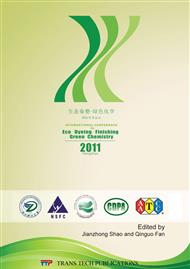p.564
p.568
p.573
p.578
p.584
p.589
p.593
p.598
p.603
Comparative Study on the Treatment of Biologically Treated Textile Effluent by Nanofiltration and Reverse Osmosis for Water Reuse
Abstract:
In view of the water shortage, the increasingly severe regulations as well as the release thresholds, it is becoming increasingly necessary to reuse the textile effluents. This work concerned the treatment of textile plant effluent after conventional biological processing by membrane technology for water reuse. Desal5 DK nanofiltration (NF) membrane and BW30 reverse osmosis (RO) membrane were investigated in this study in terms of COD and color removal, salinity reduction as well as permeate flux through cross-flow permeation tests. The results showed that the Desal5 DK nanofiltration membrane exhibited higher stabilized water permeability and flux decline than the reverse osmosis membrane because of its higher porosity and tendency towards fouling. The BW30 reverse osmosis membrane reduced salinity to a great extent than the Desal5 DK nanofiltration membrane. While the nanofiltration membrane exhibited better COD removal efficiency compared to the RO membrane, possibly due to its sieving removal mechanism. The treated water with good enough quality could be recycled back into the process, thereby offering economical benefits by reducing the water consumption and wastewater treatment cost.
Info:
Periodical:
Pages:
584-588
Citation:
Online since:
January 2012
Authors:
Price:
Сopyright:
© 2012 Trans Tech Publications Ltd. All Rights Reserved
Share:
Citation:



